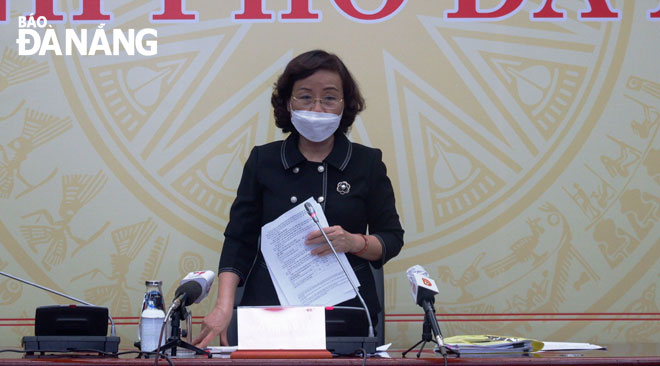Da Nang focuses on COVID-19 risk level assessments for effective prevention during Tet break
Da Nang’s relevant agencies must proactively assess the COVID-19 situation before, during and after the upcoming Lunar New Year 2022 (Tet) break, maintain necessary prevention measures and take the initiative in terms of plans, supplies and biological products, especially in the treatment of COVID-19 patients.
 |
| Da Nang People’s Committee Vice Chairwoman Ngo Thi Kim Yen delivers a directive speech at a meeting with the leaders of the municipal Steering Committee for COVID-19 Prevention and Control, January 27, 2022. Photo: PHAN CHUNG |
The above-mentioned directions were made by Da Nang People’s Committee Vice Chairwoman Ngo Thi Kim Yen at a recent meeting with members of the municipal Steering board for COVID-19 Prevention and Control.
On January 27, the Vietnamese Ministry of Health issued new guidelines on COVID-19 risk level assessment, in line with the national government’s resolution on the safe and flexible adaptation to, and the effective control of the pandemic.
Accordingly, the assessment of COVID-19 risk level of a locality must be based on three criteria, namely new COVID-19 cases in an area per population over a period of time, vaccination coverage and the capacity of medical facilities.
A locality’s pandemic level then can be determined as follows, with Level 1 being the lowest risk and Level 4 the highest.
Up to now, the COVID-19 situation in Da Nang is still complicated as the daily caseload is nearly 1,000. Therefore, the practice of safety measures against COVID-19 is still a must-do.
Especially, before, during and after Tet break, many celebrations, shopping and festivals will take place across the city. Functional forces must raise public awareness of proactively preventing COVID-19 with a top priority given to implementing the 5K protocols: khau trang (facemask), khu khuan (disinfection), khoang cach (distance), khong tu tap (no gathering) and khai bao y te (health declaration).
As for the treatment of COVID-19 patients, Vice Chairwoman Yen urged a need to strengthen the grassroots healthcare system, especially the operational efficiency of mobile medical stations, and have a backup plan in the event of a rise in infection numbers.
In addition, medical facilities must operate around the clock and map out plans to reserve enough drugs, supplies, medical equipment and chemicals in service for COVID-19 treatment.
“It’s a need to ensure a standing system of emergency services, ambulances, medical oxygen, ventilators and essential medical equipment for first aid and treatment of patients”, urged said Vice Chairman Yen.
Reporting PHAN CHUNG – Translating by A.THU